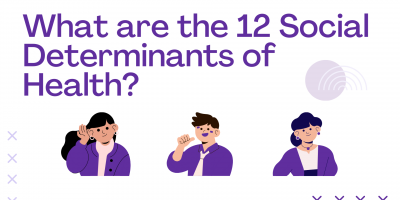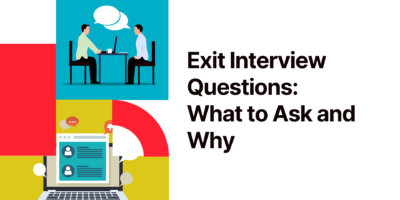
What are the Social Determinants of Health?
Could your zip code, income, and job be more crucial to your health than your genetic code? Explore the unexpected ways social determinants shape our well-being.


Partner at Contented Cow Partners

CEO of Undivided.io
After the Great Resignation came the Great Regret.
In 2021, roughly 47 million people quit their jobs. Over the next year, according to Statista, this number reached over 50 million, with a peak between November 2021 and April 2022, when voluntary resignations climbed to 4.5 million per month on average.
Since then, the situation has calmed down and is approaching pre-pandemic levels.
However, employee regret emerged as a new challenge.
Faced with the reality that their new employer might not offer better work experience than their old one, job hoppers lead the new trend called the Great Regret, which also causes an influx of boomerang employees.
While, on the surface, it’s a bad look for the workforce, the Great Resignation Regret exposes underlying issues in the workplace, urging employers to make some very needed changes.
The phenomenon we now refer to as the Great Resignation reshaped the landscape of the modern workforce, leading to a record year for quitting (2022).
After the COVID-19 pandemic and a thorough re-evaluation of work-life balance and professional priorities, workers started exploring their alternatives.
With a surge in candidates, HR teams and recruiters could choose high-quality applicants and hire from more extensive and diverse talent pools. While some organizations seized this opportunity to reassess their policies, benefits, and overall work culture, regrettably, many did not.
A Harris Poll survey for USA Today reveals that only 26% of job hoppers liked their new workplace enough to stay.
Dubbed a workplace trend, the Great Regret describes the disappointment and unmet expectations that came in the post-resignation period, particularly for those who changed employers in pursuit of better conditions.
“Some found themselves to be cultural misfits, while others really missed their old “buds” at the previous job,“ says Bill Catlette, Partner at Contented Cow Partners.
Catlette adds: “Some have stayed and tried to adapt, whereas many others have begun casting their resumes upon the water in search of the next new thing.
Some have returned to their old jobs.
As one might imagine, this has visited considerable (and expensive) disruption on the involved organizations.“
In the wake of the Great Resignation Regret, exploring the underlying factors that contributed to this widespread wave of resignations becomes crucial.

It wasn’t just about getting a better job or a salary.
During COVID-19 and post-pandemic, employees experienced heightened rates of stress and burnout.
For many, this was a wake-up call to search for more fulfilling careers.
Others used this opportunity to upskill or reskill and align themselves with industries or roles that were more appealing.
At the same time, remote work removed location boundaries and allowed for more flexible jobs. This shift has not only made work more accessible but also emphasized the growing importance of networking and employee referrals in navigating the high talent demand.
According to Harvard economist Jason Furman, the increase in turnover was in line with the rising number of job openings.
In an article for the Peterson Institute for International Economics (PIIE), Furman argues that employees had the confidence to resign, knowing they could find a new and better job more efficiently.
And while some did, many were left disappointed.
The wave of job quits was bound to have consequences.
With such a high turnover, workers leaving their employers for better ones left room for others to take their spots. Assuming their “replacements” were also searching for better working conditions, it’s easy to see how overall discontent can happen.
Exploring this, HR, payroll, and benefits provider Paychex finds that eight in ten employees regret quitting during the Great Resignation.
GenZ and workers who changed industries were most likely to feel regretful, while mental health, work-life balance, and workplace relationships took the hardest hit.
Moreover, white-collar employees were 15% more likely to feel the Great Regret.
Hiring was another aspect that backfired for workers, as 50% struggled to land a new job for three to six months.
Another 39% searched for a new position for seven months or longer.
Paychex’s recent survey provides valuable insight into the Great Resignation Regret by exploring how it affected U.S. employees and employers.
From the factors and how they influence each generation to how employers feel about it, this study sheds light on the aftermath of the mass resignations.

According to Paychex, employees who quit their jobs, among other things, were looking for better mental health and work-life balance.
Unfortunately, only about half of them got it in their new workplace.
As for salaries, another important factor contributing to mass resignations, Paychex shows that employees were only 11% more likely to be satisfied with their new salary.
On what they missed the most from their old employer, the study lists the following as factors contributing to regret:
The findings further show that workers from large companies were most likely to miss their work-life balance, while those working for small employers missed their co-workers the most.
If we look at the generation-specific insights from the Paychex study, it’s evident that GenZ experiences the most regret.
In fact, 89% of the youngest generation in the workforce have felt the consequences of changing their jobs during the Great Resignation. They also report the lowest levels of positive mental health and work-life balance and are most likely to miss working in the office.
Millennials were the least regretful generation, with 77%.
As for Generation X, the survey reveals that they were 20% more likely to miss work-life balance than other age groups.

Irrespective of their age or specific factors, many employees felt regretful and even surprised once they found out their new job wasn’t anything like they were led to believe.
Co-founder and CEO of Muse, Kathryn Minshew, calls it the “Shift Shock.”
Surveying more than 2,500 people, Muse reveals that 72% of respondents have experienced this phenomenon.
Findings also show that almost half, or 48%, would try to get their old job back.
These are the “boomerang employees,” or workers that leave a company for personal reasons and then return as rehired employees.
But how do employers feel about them?
For CNBC Make It, Jeff Williams, VP of enterprise and HR solutions at Paychex, explains that more employers than ever are open-minded to the idea of the boomerang employees returning to their old jobs.
“Tight labor markets, specialized skills, time-to-performance, and knowing the quality of work expected are all cited as reasons by hiring managers. Those with hesitancy to rehire highlight loyalty, expected compensation, and underlying suspicion of the employee’s motives,” he says.
If we look at the numbers from the study, 78% of job hoppers want their job back, and 70% of employers have either given or want to give ex-employees their job back.
Another 60% are willing to offer additional benefits to returning employees, including a better salary, remote work, and flexible working hours.
Still, 30% of all respondents wouldn’t rehire employees.
Unsurprisingly, workplace loyalty significantly contributes to this, especially for blue-collar employers, who are 17% more likely than white-collar employers to feel this way.
This difference in opinions highlights the difficulties for returning employees as they try to fit back into the workforce.
Will the Great Return be next after the Great Resignation and the Great Regret?
A study by UKG shows that almost one in five workers who quit during the pandemic boomeranged to their old jobs. Moreover, findings show that their resignations were for more personal reasons compared to other job quitters. Boomerang employees also reported having a strong and supportive manager.
However, even though this somewhat mitigates the Great Resignation Regret, returning employees still face many challenges.
For one, they continue to seek acknowledgment and tangible changes within the workplace. Moreover, according to Google Trends, burnout awareness continues to surge.
Conversely, companies are tasked with improving their hiring practices, focusing on employee well-being, and fostering a culture that values open dialogue.
So, what seems to be the solution?
The Great Regret has shown us that it’s not just about changing jobs or filling the turnover gap.
A tangible solution requires reevaluating and challenging traditional workplace structures and fostering environments that promote employee satisfaction and retention.
Asked how companies can minimize this phenomenon and enhance workers’ engagement, Bill Catlette explains: “Recruiters, HR, and hiring managers need to do a better job of identifying and selecting not just well-qualified candidates, but those who, by virtue of pace, preference, values, and temperament actually are good fits for the given workplace.”
Beyond hiring the right people, Seth Besse, CEO of Undivided.io, argues that companies must acknowledge that their workforce seeks a more profound sense of purpose and belonging in their professional lives.
“By empowering our employees, recognizing their contributions, and fostering inclusion, we can unlock their full potential and create an environment where everyone can thrive.”
Besse adds: “However, building an inclusive work culture requires more than just providing team swag and playing cooperative games.
When employees don’t feel appreciated, they may question the value of their work.
This is where timely praise for even small accomplishments can demonstrate your appreciation and understanding of their efforts. And offering robust professional development opportunities, mentorship programs, and opportunities to acquire new skills can reignite their passion and motivation.
But most importantly, listening allows you to gain a greater awareness and understanding of each employee’s unique interests and motivators. It also gives them a chance to discuss issues or opportunities you may not have seen.”

Mass resignation might be subsiding, but workers’ dedication to seeking better working conditions remains unwavering.
Companies seem more aware of the importance of rehiring former employees, bringing hope to those considering a change and aiming to reduce their regret.
Amidst these changes, often stigmatized, job hoppers are making the most of the new work landscape.
They get exposed to new environments and networking opportunities while playing a dynamic role in shaping the talent market with their diverse skills and experiences.
Now, they are also driving the latest trends like rage applying and lazy girl jobs, which reflect how workers started prioritizing their well-being and ditching toxic workplaces.
Millennials and Gen Z lead these changes, showing a shift in what people expect from their employers.
Yet, the desire for well-being at work goes beyond generations.
The Great Regret after the Great Resignation is another response, pushing for a workplace focused on commitment, flexibility, and well-being—an imperative for employers and employees.
Content Writer at Shortlister
Browse our curated list of vendors to find the best solution for your needs.
Subscribe to our newsletter for the latest trends, expert tips, and workplace insights!

Could your zip code, income, and job be more crucial to your health than your genetic code? Explore the unexpected ways social determinants shape our well-being.

Uncover how a strong employer branding strategy will help you lower the cost of hiring, attract better quality hires, and differentiate you from competitors.

Why are your employees leaving? Asking the right exit interview questions reveals the pattern behind high turnover and transforms offboarding into a roadmap for retention.

Value-based connections, hybrid events, expansion of AI, and the metaverse. In the ever-expanding networking realm, here’s what to look out for in 2025.
Used by most of the top employee benefits consultants in the US, Shortlister is where you can find, research and select HR and benefits vendors for your clients.
Shortlister helps you reach your ideal prospects. Claim your free account to control your message and receive employer, consultant and health plan leads.